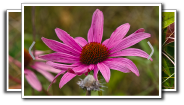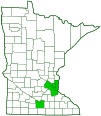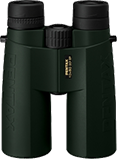northern yellow sac spider
(Cheiracanthium mildei)
Conservation • Description • Habitat • Biology • Distribution • Taxonomy
Conservation Status |
|
|||||||
| IUCN Red List | not listed |
|||||||
| NatureServe | NNR - Unranked |
|||||||
| Minnesota | not listed |
|||||||
Description |
||
Northern yellow sac spider is an exotic, relatively small, longlegged sac spider. It is native to Europe, North Africa, the Middle East, Turkey, and central Asia. It was probably introduced into the United States in the 1940s. The first North American record is from Connecticut in the summer of 1949. Since then, it has spread rapidly. It now occurs throughout southern Canada, the United States, Mexico, and Central America. It is most common in the northeast and in major metropolitan areas. In Minnesota, it has been reported only in the Twin Cities Metro area and in Mankato. It is found on low tree limbs, on shrubs, on plant foliage, in gardens, and on buildings. More often, it is found indoors in houses and other man-made structures, especially in fall and winter. Females are ¼″ to ⅜″ (7 to 10 mm) in length and have a ½″ to 11⁄16″ (12 to 18 mm) legspan. The front part of the body (cephalothorax) is longer than wide. The upper part (carapace) is orangish-yellow or yellowish-green. There is no longitudinal furrow (median groove) on the carapace but there is a slightly darkened line in that area, a “false groove.” There are eight eyes in two rows of four. All of the eyes are about the same size. The front row is slightly curved backward. The rear row is curved forward. The eyes in each row are equally spaced, the median eyes are the same distance from the lateral eyes as they are from each other. The jaws (chelicerae) are large, dark brown, and prominent. The forward-facing margin has three teeth, the rear-facing margin has two teeth. Each fang rests in a furrow between two ridges (margins). The lower margin has three teeth. The abdomen is oval, longer than wide, and convex when viewed from the side. It is dull yellow or pale green with a slightly darker cardiac mark near the front but with no other markings. The legs are long and yellow. The first pair of legs is longer than all the others. All legs have two claws at the tip. On each leg, the tip of the fifth segment (metatarsus) and sixth segment (tarsus) are black. This feature gives the spider one of its common names, "blackfooted spider". Males are smaller, 3⁄16″ to 5⁄16″ (5.5 to 8.5 mm) in length. |
||
Size |
||
Female Body Length: ¼″ to ⅜″ (7 to 10 mm) Male Body Length: 3⁄16″ to 5⁄16″ (5.5 to 8.5 mm) Legspan: ½″ to 11⁄16″ (12 to 18 mm) |
||
Web |
||
Sac spiders do not construct hunting webs, but they will build a silken retreat and nest. |
||
Similar Species |
||
Habitat |
||
Low tree limbs, shrubs, plant foliage, gardens, and buildings, often indoors. |
||
Biology |
||
Season |
||
Indoors: year-round Outdoors: ? |
||
Behavior |
||
Northern yellow sac spiders are active at night. They spend the day hiding in a silken tubular retreat, the “sac” that this family is named for. When outdoors, the retreat is usually made in a folded over leaf. |
||
Life Cycle |
||
When outside, adults or subadults may hibernate under leaves or in a retreat under a rock or under bark. |
||
Food |
||
Small insects |
||
Toxicity |
||
Northern yellow sac spiders, like most spiders, are venomous. They are defensive and will bite humans when threatened, as when they are trapped in clothing. However, the effects of the bite are mild. The bitten area may be painful for about one hour and forty-five minutes, but it does not cause the skin around the bite to die (necrosis). |
||
Distribution |
||||
|
Sources |
|||
| 8/15/2023 | ||||
Occurrence |
||||
|
||||
Taxonomy |
|||
| Class | Arachnida (arachnids) | ||
Order |
Araneae (spiders) | ||
Suborder |
Araneomorphae (typical spiders) | ||
| Infraorder | Entelegynae | ||
Superfamily |
Corinnoidea | ||
Family |
Cheiracanthiidae (longlegged sac spiders) | ||
Genus |
Cheiracanthium (longlegged sac spiders) | ||
Synonyms |
|||
Cheiracanthium anceps Cheiracanthium cretense Cheiracanthium strasseni |
|||
Common Names |
|||
blackfooted spider longlegged sac spider long-legged sac spider northern yellow sac spider yellow sac spider |
|||
Glossary
Carapace
The hard, upper (dorsal), shell-like covering (exoskeleton) of the body or at least the thorax of many arthropods and of turtles and tortoises. On crustaceans, it covers the cephalothorax. On spiders, the top of the cephalothorax made from a series of fused sclerites.
Cardiac mark
An oval dark mark on the front half of the abdomen of some spiders, beneath which lies the heart.
Cephalothorax
The front part of the body of various arthropods, composed of the head region and the thoracic area fused together. Eyes, legs, and antennae are attached to this part.
Chelicerae
The pair of stout mouthparts, corresponding to jaws, in arachnids and other arthropods in the subphylum Chelicerata.
Metatarsus
The sixth segment of a spider leg.
Tarsus
On insects, the last two to five subdivisions of the leg, attached to the tibia; the foot. On spiders, the last segment of the leg. Plural: tarsi.
Visitor Photos |
|||||
Share your photo of this arachnid. |
|||||
| This button not working for you? Simply email us at info@MinnesotaSeasons.com. Attach one or more photos and, if you like, a caption. |
|||||
Alissa Hawkins |
|||||
 |
 |
||||
Alfredo Colon |
|||||
 |
|||||
MinnesotaSeasons.com Photos |
|||||
|
|||||

Slideshows |
||

Visitor Videos |
|||
Share your video of this arachnid. |
|||
| This button not working for you? Simply email us at info@MinnesotaSeasons.com. Attach a video, a YouTube link, or a cloud storage link. |
|||
Other Videos |
|||
| The Spiders in your House - The Yellow Sac Spider Travis McEnery |
|||
About
Dec 26, 2022 A close look at Cheiracanthium mildei, the Yellow Sac Spider, how it will behave (and affect you) living in your house, the bite and the venom, and other fascinating stuff. All photos and video are my own, UNLESS OTHERWISE CREDITED. Note that I am an amateur, not a professional. If you think I have made a mistake, let me know in the comments! Support me on Patreon: |
|||
| How Dangerous is the Yellow Sac Spider? Life Underfoot |
|||
About
May 25, 2020 Yellow sac spiders are a common spider in houses all over the world, but are they dangerous to humans? Many peope fear the venom of the yellow sac spider, but in this video we break down why you don't need to be afraid of this little spider! If you want to dig further into some of the science we discuss here, check out these publications: Verified bites by yellow sac spiders (genus Cheiracanthium) in the United States and Australia: where is the necrosis? -- https://www.semanticscholar.org/paper/Verified-bites-by-yellow-sac-spiders-%28genus-in-the-Vetter-Isbister/863a05c86468b67ac574f4bf5fade100b1e1f349?p2df How Dietary Plant Nectar Affects the Survival, Growth, and Fecundity of a Cursorial Spider Cheiracanthium inclusum (Araneae: Miturgidae) -- https://academic.oup.com/ee/article/38/5/1379/407140?login=false Intro/Outro music from "Under the Sun" by DIIV, licensed through IMovie |
|||

Created: 8/15/2023
Last Updated:



